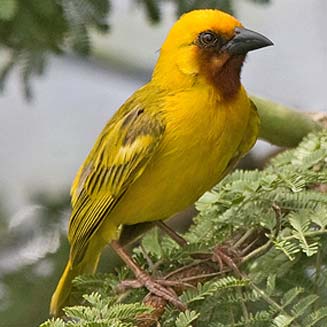|
Ploceus xanthopterus
(Southern brown-throated weaver)
Bruinkeelwewer [Afrikaans];
Bruinkeelwever [Dutch]; Tisserin à gorge brune [French]; Braunkehlweber
[German]; Tecelão-de-garganta-castanha [Portuguese]
Life
> Eukaryotes >
Opisthokonta
> Metazoa (animals) >
Bilateria >
Deuterostomia > Chordata >
Craniata > Vertebrata (vertebrates) > Gnathostomata (jawed
vertebrates) > Teleostomi (teleost fish) > Osteichthyes (bony fish) > Class:
Sarcopterygii (lobe-finned
fish) > Stegocephalia (terrestrial
vertebrates) > Tetrapoda
(four-legged vertebrates) > Reptiliomorpha > Amniota >
Reptilia (reptiles) >
Romeriida > Diapsida > Archosauromorpha > Archosauria >
Dinosauria
(dinosaurs) > Saurischia > Theropoda (bipedal predatory dinosaurs) >
Coelurosauria > Maniraptora > Aves
(birds) >
Order: Passeriformes > Family: Ploceidae
> Genus: Ploceus
 |
 |
|
Southern brown-throated weaver male, Botswana. [photo
Neil Gray
©] |
Southern brown-throated weaver female, Botswana. [photo
Neil Gray
©] |
Distribution and habitat
Occurs from southern Tanzania and north-eastern Mozambique
through Zambia and Angola to southern Africa. Here it is uncommon and localised
in three separate areas: northern Botswana and the Caprivi Strip (Namibia),
north-eastern Zimbabwe and central Mozambique and from southern Mozambique to
KwaZulu-Natal. It generally prefers reedbeds and Papyrus (Cyperus papyrus)
swamps while breeding, but in the non-breeding season it may also move into
woodland, thickets, grassland and forest.
|
 |
|
Distribution of Southern brown-throated weaver in
southern Africa, based on statistical smoothing of the records from
first SA Bird Atlas Project (©
Animal Demography unit, University of
Cape Town; smoothing by Birgit Erni and Francesca Little). Colours range
from dark blue (most common) through to yellow (least common).
See here for the latest distribution
from the SABAP2. |
Food
It mainly eats insects, seeds, berries and flowers, doing
most of its foraging in vegetation, gleaning food from leaves and branches. The following food items have been recorded
in its diet:
- Plants
- seeds
- Panicum maximum (Guinea grass)
- berries
- flowers
- Insects
- Human food
Breeding
- Polygynous, as males mate with multiple females per breeding season,
either nesting singly or in colonies of 10-300 nests.
- The male may build up to about 12 nests in a breeding season, which
consist of an untidy oval with an entrance hole on the bottom, woven from
thin strips of reeds or grass and lined by the female with grass seedheads
and reed flowers. It is typically attached to 1-3 reed stems at least one
metre above water, rarely using a tree instead.
- Egg-laying season is from about October-January.
- It lays 2-3 eggs, which are incubated solely by the female for about
14-17 days.
- The chicks are fed by the female only, leaving the nest after about
14-19 days.
Threats
Not threatened, although it is very vulnerable to the
destruction of wetlands.
References
-
Hockey PAR, Dean WRJ and Ryan PG 2005. Roberts
- Birds of southern Africa, VIIth ed. The Trustees of the John Voelcker
Bird Book Fund, Cape Town.
|
